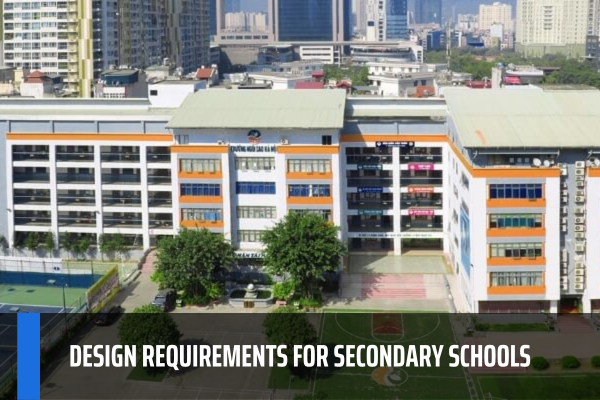TCVN 8794:2011: What are the regulations on design requirements for secondary schools? What are the general design requirements for secondary schools in Vietnam?
TCVN 8794:2011: What is the scope of application of design requirements for secondary schools in Vietnam?
TCVN 8794:2011 applies to design when building new or renovating lower secondary schools and upper secondary schools (hereinafter collectively referred to as secondary schools).
The standards can also be applied to secondary schools with many levels, boarding schools for ethnic minorities and semi-boarding schools for ethnic minorities.
NOTE: lower secondary schools include grades 6 to 9, and upper secondary schools include grades 10 to 12.

TCVN 8794:2011: What are the regulations on design requirements for secondary schools? What are the general design requirements for secondary schools in Vietnam? (Image from the Internet)
What are the general regulations on designs of secondary schools in Vietnam?
Pursuant to Section 3 of Standard TCVN 8794:2011 as follows:
General rules
3.1 Secondary schools planning must be consistent with the secondary school network planning in the area and meet socio-economic development requirements. Planning criteria are determined according to the following regulations:
- Lower secondary schools: from 55 seats to 70 seats for 1,000 people;
- Upper secondary schools: from 45 to 60 seats for 1,000 people.
3.2 Secondary schools are designed to have a maximum of 45 classes with the number of students in each class not greater than 45 students.
3.3 The scale of secondary schools with boarding or semi-boarding is determined depending on specific conditions and designed according to specific design tasks.
NOTE: For ethnic minority boarding schools, it is necessary to arrange public housing for teachers.
3.4 It is possible to design and build schools with many different educational levels on the same land, but must ensure the separate operation of each educational level.
NOTE: The ratio between educational levels depends on the scale and actual requirements of the construction site and relevant regulations.
3.5 secondary schools are designed with construction levels according to regulations in documents on classification and grading of civil, industrial and urban technical infrastructure [1].
3.6 In a school, it is allowed to design and construct items of different construction levels, but priority must be given to the highest construction level for the school block.
3.7 Requirements to ensure life safety and health for students must comply with regulations in documents on life safety and health in homes and buildings [2].
3.8 When designing and constructing secondary schools, it is necessary to take into account the need to accept students with disabilities and comply with the regulations in TCVN2): , Civil works - Basic principles of construction to ensure access for people with disabilities use.
Thus, the design of secondary schools must meet the above regulations.
What are the completion requirements for secondary schools in Vietnam?
Pursuant to Section 7 of TCVN 8794:2011 on completion work for secondary schools must meet the following requirements:
(1) Finishing work must be focused both inside and outside the building as well as the garden, fence and school gate. School name signs comply with regulations of the Ministry of Education and Training.
(2) Architectural details, wall edges, column edges... must not have square edges or sharp corners. The doors and windows of the classrooms must have wind hooks to hold the folding doors against the wall.
(3) Distance from the floor to the window sill is not less than 1.40 m to avoid impact. Room doors must meet the requirements of natural lighting, ventilation, shield cold wind, rain, and sunlight shining through the room, while ensuring convenience, safety in use, and ease of cleaning.
(4) Interior and exterior wall surfaces should be made from smooth, flat materials that are easy to clean. Ceilings and floors must be smooth, with few burrs or steps.
(5) Floors and floors of bathrooms must meet the following requirements:
- Have a slope of 1% to 2% towards the sump or drainage hole at the base of the wall, close to the floor;
- Paved with non-slip, waterproof, easy-to-clean material.
(6) The subject classroom floors and floors must be easy to clean, non-slip, have no gaps, are not abrasive, are not deformed, are moisture-proof, avoid being wet and can withstand impact of chemicals.
(7) Subject classrooms need to have projection equipment such as projectors, object projectors, and computers. Informatics classrooms are equipped with servers and networked computer systems.
(8) The quantity of teaching equipment in subject classrooms must comply with the regulations in the list of minimum teaching equipment issued by the Minister of Education and Training. Schools can equip additional teaching equipment.
(9) Finishing materials need to ensure durability requirements, not be dangerous or toxic, be easy to clean, limit abrasion, not be deformed, ensure aesthetic requirements and be consistent with the conditions. climate conditions.
There are termite prevention measures for the project.
(10) The roof design solution must ensure the requirements of heat resistance, noise protection, waterproofing, anti-corrosion, rain protection and storm resistance. When using roofing sheets for urban, rural, remote, coastal, storm and tornado areas, technical requirements, on design requirements and installation instructions must be followed. in TCVN 8052-1:2009 and TCVN 8053:2009.
(11) When completing the garden, ensure:
- Gardens, lawns, and school grounds must be in the right location, meeting the general living requirements of students;
- The correct type of plants has been prescribed and is of good quality.
(12) Internal roads must ensure:
- Correct location and size according to regulations;
- Correct usage requirements and functions;
- Convenient to contact and suitable for the landscape architecture of the project.
(13) Must regularly maintain and maintain buildings and equipment (especially outdoor equipment).
Take care of flower gardens and trees to maintain a green, clean, and beautiful educational environment.
LawNet